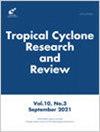台风委员会地区台风相关灾害风险预警中的大数据和人工智能应用综述
IF 4.1
4区 地球科学
Q3 METEOROLOGY & ATMOSPHERIC SCIENCES
引用次数: 0
摘要
亚太经社会/世界气象组织台风委员会成员每年都直接或间接受到台风的影响。各成员在应对台风负面影响方面积累了丰富的经验,并以不同的方式发展了与台风有关的灾害风险预测和预警技术和措施,以减少台风造成的损害。然而,由于天气条件的不断变化,要准确预测台风的发生,并在早期预警其潜在影响,仍然面临许多困难和挑战。随着信息技术(IT)和计算科学的发展,以及近几十年来积累的水文气象数据的不断增加,科学家、研究人员和操作人员不断尝试基于大数据和人工智能(AI)技术的应用来改进预报模型,以提高台风相关灾害风险预测和预警能力。本文综述了大数据和人工智能技术在台风灾害风险预报预警方面的应用现状,探讨了未来有效利用大数据和人工智能技术在台风灾害风险降低方面的应用所面临的挑战和限制。本文章由计算机程序翻译,如有差异,请以英文原文为准。
Review of big-data and AI application in typhoon-related disaster risk early warning in Typhoon Committee region
ESCAP/WMO Typhoon Committee Members are directly or indirectly affected by typhoons every year. Members have accumulated rich experiences dealing with typhoons' negative impact and developed the technologies and measures on typhoon-related disaster risk forecasting and early warning in various ways to reduce the damage caused by typhoon. However, it is still facing many difficulties and challenges to accurately forecast the occurrence of typhoons and warning the potential impacts in an early stage due to the continuously changing weather conditions. With the development of information technology (IT) and computing science, and increasing accumulated hydro-meteorological data in recent decades, scientists, researchers and operationers keep trying to improve forecasting models based on the application of big data and artificial intelligent (AI) technology to promote the capacity of typhoon-related disaster risk forecasting and early warning. This paper reviewed the current status of application of big data and AI technology in the aspect of typhoon-related disaster risk forecasting and early warning, and discussed the challenges and limitations that must be addressed to effectively harness the power of big data and AI technology application in typhoon-related disaster risk reduction in the future.
求助全文
通过发布文献求助,成功后即可免费获取论文全文。
去求助
来源期刊

Tropical Cyclone Research and Review
METEOROLOGY & ATMOSPHERIC SCIENCES-
CiteScore
4.60
自引率
3.40%
发文量
184
审稿时长
30 weeks
期刊介绍:
Tropical Cyclone Research and Review is an international journal focusing on tropical cyclone monitoring, forecasting, and research as well as associated hydrological effects and disaster risk reduction. This journal is edited and published by the ESCAP/WMO Typhoon Committee (TC) and the Shanghai Typhoon Institute of the China Meteorology Administration (STI/CMA). Contributions from all tropical cyclone basins are welcome.
Scope of the journal includes:
• Reviews of tropical cyclones exhibiting unusual characteristics or behavior or resulting in disastrous impacts on Typhoon Committee Members and other regional WMO bodies
• Advances in applied and basic tropical cyclone research or technology to improve tropical cyclone forecasts and warnings
• Basic theoretical studies of tropical cyclones
• Event reports, compelling images, and topic review reports of tropical cyclones
• Impacts, risk assessments, and risk management techniques related to tropical cyclones
 求助内容:
求助内容: 应助结果提醒方式:
应助结果提醒方式:


